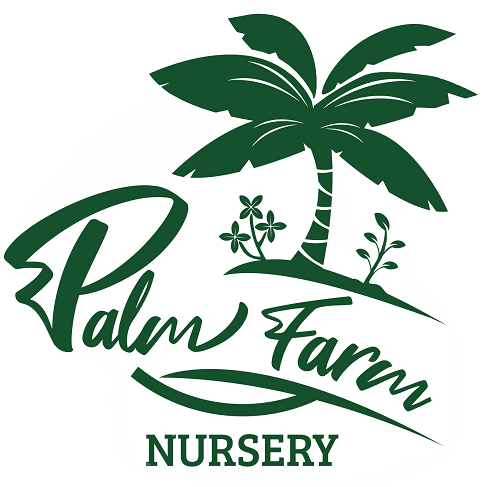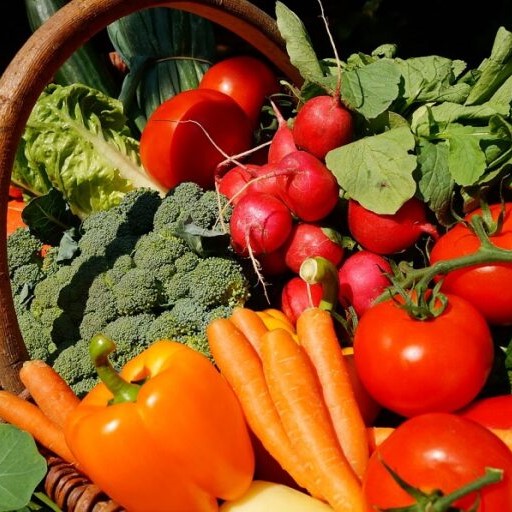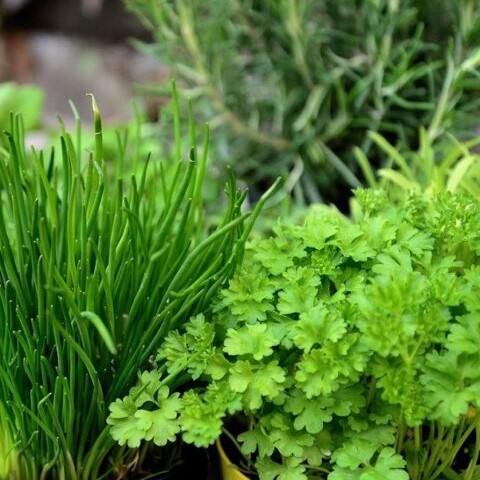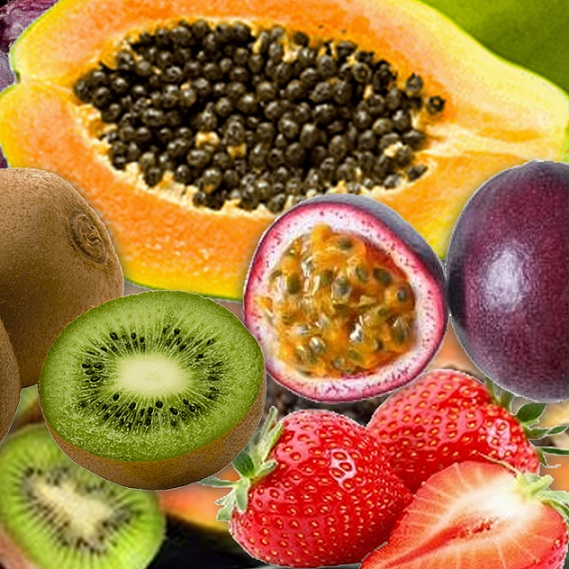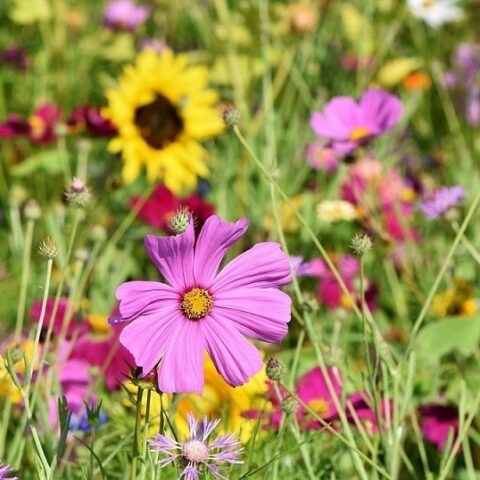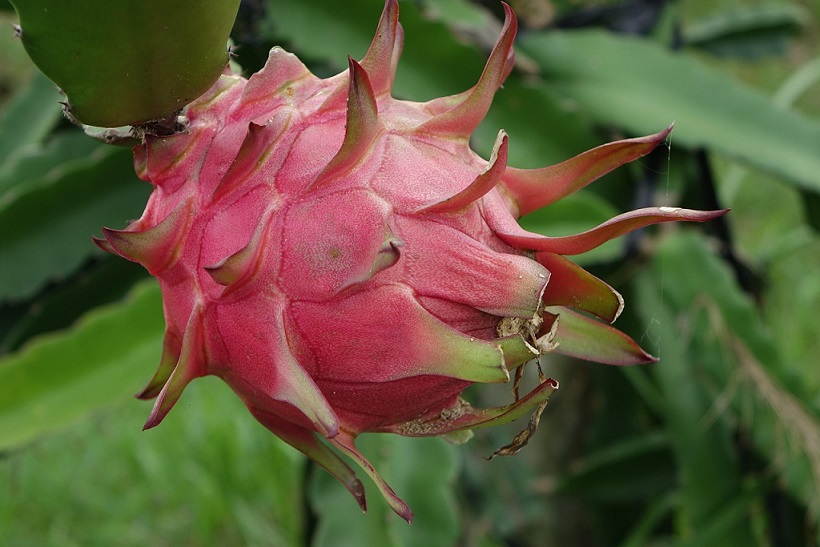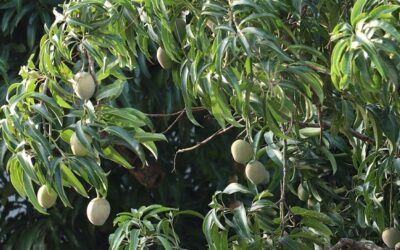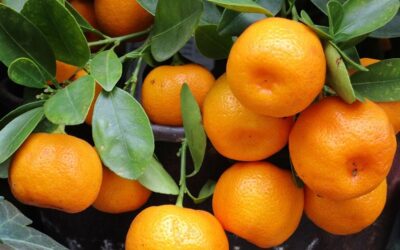1. Introduction
Overview
Dragon fruit, or pitaya, is a tropical cactus fruit known for its vibrant pink, red, or yellow scaly exterior, and sweet white, pink, or red flesh with tiny black seeds. Native to Central and South America, it is now grown worldwide and valued for its unique taste and health benefits. Low in calories and rich in fibre and antioxidants, its mildly sweet flavour is often compared to a mix of pear and kiwi, with a texture similar to kiwi or watermelon.
Benefits of Growing Dragon Fruit
According to the Fresh Fruit Portal, the global dragon fruit market is set for significant growth, presenting a profitable opportunity for Zambian farmers due to the country’s favourable climate. Dragon fruit’s rising popularity comes from its unique appearance, mild sweetness, and many health benefits. It is rich in Vitamin C, a powerful antioxidant that boosts immunity, and provides essential nutrients like fibre, iron, and magnesium. With prebiotics that support gut health and antioxidants like carotenoids, dragon fruit aids digestion, heart health, and energy production, making it a valuable addition to a nutritious diet.
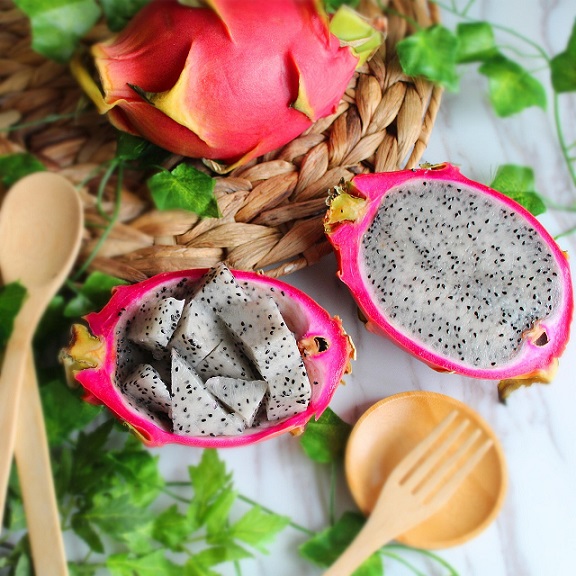
2. Choosing the Right Variety
While there is no single “wrong” variety of dragon fruit, choosing the right one largely depends on personal preference, dietary goals, and market demands. Selecting the appropriate variety can help optimise nutritional intake, promote overall health and well-being, or target a specific market with the highest sugar content.
A smart approach is to grow multiple varieties together; this extends the harvest season, improves cross-pollination for better fruit production, increases resistance to pests and diseases through genetic diversity, and allows you to meet a wider range of market needs.
Common types:
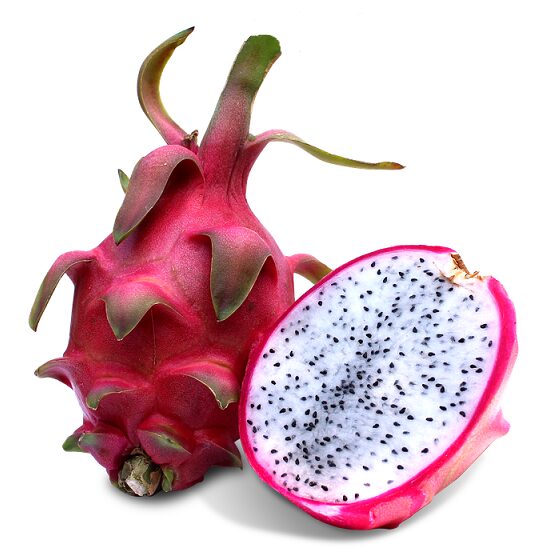
Hylocereus undatus (pink skin, white or pink flesh):
A hardy, easy-to-grow, and highly fertile variety with a mild flavour.
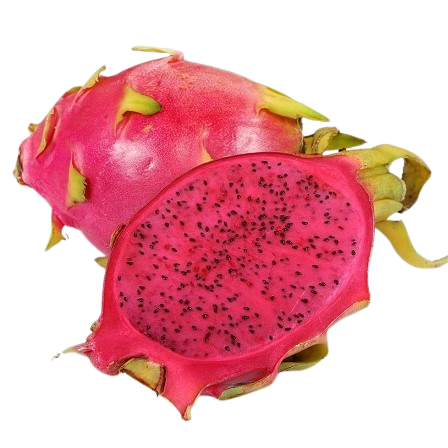
Hylocereus costaricensis (pink skin, red flesh):
Offers the most nutritional and health benefits; sweeter and more flavourful than undatus.
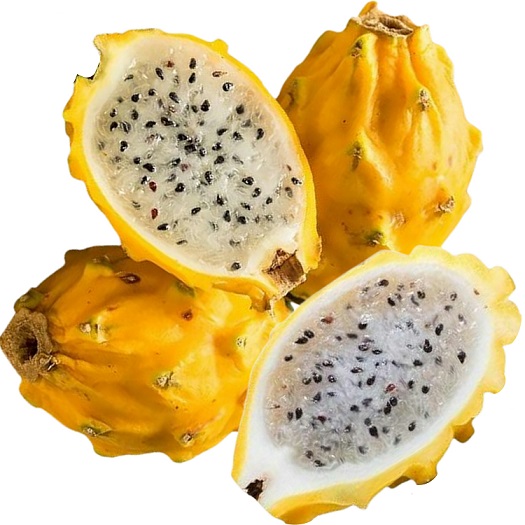
Hylocereus megalanthus (yellow skin, white flesh):
Very juicy, and known as the sweetest and most flavourful variety.
3. Ideal Growing Conditions
Climate: Prefers warm, tropical to subtropical climates (18–36 °C).
Sunlight: Requires at least 6–8 hours of direct sunlight daily.
Soil: Organic-rich, well-draining sandy or loamy soil (pH 6–7). Dragon fruit cacti are not terribly fussy about soil type or pH, as long as the soil is moist, rich in organic matter, and well-draining. Boost the soil with compost, manure, worm castings, or organic pelletised fertiliser. A dose of lime is also beneficial.
Support Structure: There are various types of trellis systems suitable for supporting dragon fruit, ranging from single vertical posts to wire systems stretched across rows and supported by evenly spaced poles. Whatever the design, the materials used must be strong enough to support the weight of the multi-stemmed plant.
For dragon fruit cultivation in Zambia, an ideal pole height is approximately 1.5 m. This allows the plant to climb and branch out effectively, while also keeping the fruit within easy reach for harvesting. It is recommended to plant two dragon fruit plants per post.
4. Planting Guide
Planting
If you are planting your dragon fruit orchard using cuttings, allow the cuttings to dry for about 6 days before planting. This encourages faster rooting and results in stronger roots.
The ideal spacing for dragon fruit posts is 2 m apart in rows and 5 m between rows. On each post, two vines are planted, so the plant population per hectare will be double the post numbers (1,000 posts, 2,000 plants per hectare). This spacing ensures that maintenance equipment can move freely between the rows. For high-density planting, use 2 m apart in rows and 3 m between rows (1,600 posts, 3,200 plants per hectare).
Training
Tie two main stems to the support structure to encourage vertical growth. Remove all side shoots as the plant grows upward. Once it reaches the desired height, trim the top to promote branching. Then, guide the top branches to hang over the support ring or wires. A well-grown vine may produce 30 to 40 branches in one year and more than 100 branches in four years.
Watering
In the first and second year, water approximately 5 litres per plant twice a week during the hot months (August to April). From the third year onwards, increase to 10 litres per plant. If a thick straw mulch, or mulch made from any organic matter, is applied around the vines, watering may only be needed once a week. Just make sure the straw is treated with a termite repellent. Once the rains begin, additional watering is not necessary unless there is a dry spell lasting more than two weeks.
During the cooler months (May to July), reduce watering to 2 litres per plant twice a week. From the second year onwards, increase this to 5 litres per plant. Mulching will also help reduce the need for frequent watering. Avoid overwatering, as it can lead to root rot and fruit splitting. In general, water dragon fruit vines when the top 2 inches (5 cm) of soil feel dry.
Mulching
Mulch plants to protect their shallow roots. Mulch helps stabilise soil temperature, suppress weeds, keep the soil network healthy and strong, and conserve moisture, especially during the dry months from April to November. During the rainy season, mulch should be removed to help the soil dry out more quickly between showers. This helps prevent root rot and fungal diseases.
5. Care and Maintenance
Fertilisation
Choosing between organic and conventional farming methods is a major decision that will affect everything from your costs and labour to your market and yields.
Below is a detailed overview of each method, outlining their respective advantages and disadvantages:
Organic |
| Organic farming avoids synthetic chemicals like fertilizers, pesticides, herbicides, and growth hormones. Instead, it relies on natural composts, crop rotation, biological pest control, and sustainable practices. |
Pros: |
|
· Healthier produce: Free from synthetic chemicals, often preferred by health-conscious consumers. · Premium prices: Organic dragon fruit can sell for 20–50% more than conventional fruit · Environmentally friendly: Promotes soil health, biodiversity, and reduces water pollution. · Better long-term soil fertility: Organic matter builds up healthier soil over time. · Growing demand: Consumers globally are leaning toward organic food, increasing your market. |
Cons: |
|
· Lower initial yields: Organic farming often results in smaller yields during the early years. · Higher labour costs: More manual weeding, pest control required. · Certification process: Requires time, paperwork, and inspections to be certified organic. · Risk of pest outbreaks: Limited chemical control options can lead to crop loss if not managed well. |
Conventional |
| Conventional farming uses synthetic fertilizers, pesticides, herbicides, and sometimes growth enhancers to maximize yield and minimize labour costs. |
Pros: |
|
· Higher yields: With fertilizers and pest control, plants grow faster and produce more. · Lower labour costs: Less manual work due to mechanized or chemical weed/pest control. · Easier to manage: Especially at scale, as inputs are widely available and standardized. · Faster growth and return: Crops may mature quicker, allowing earlier returns on investment. |
Cons: |
|
· Chemical residue: May be harmful to consumers and could face export limitations. · Soil degradation: Over time, synthetic inputs can harm beneficial microbes and reduce soil quality. · Environmental impact: More water contamination, biodiversity loss, and the decline of beneficial insects and certain bird species. · Market competition: Lower prices and more competitors in the non-organic market. |
The program below is not a fixed rule but a rough guideline to help dragon fruit growers get started. Each grower should adjust the schedule to suit their own soil type and conditions. From the third year, conduct soil analysis to identify and correct nutrient imbalances.
Soil Preparation
Work 60mℓ dolomitic lime into each plant hole
Also add one or more of the following:
120mℓ (1/2 cup) worm castings
500mℓ compost
250mℓ (1 cup) aged cow, goat or chicken manure
Work 60mℓ dolomitic lime into each plant hole
Organic matter may also be added to the planting hole to improve soil structure and drainage.
after planting
Add organic pelletized fertilizer, work into the top soil
Add 50g Compound D per post, work into top soil
Frist year
120mℓ (1/2 cup) worm castings
500mℓ compost
500mℓ (1 cup) aged cow, goat or chicken manure
Apply 120mℓ (1/2 cup) dolomitic lime in Sept
Apply 120mℓ dolomitic lime in August and again in January
At the first sight of flower buds
Apply boron and zinc to help stimulate flower development and improve the chances of a successful fruit set
Apply boron and zinc to help stimulate flower development and improve the chances of a successful fruit set
Fruiting Stage
Apply an organic Potassium-rich fertilizer every 3 weeks, as a soil drench or foliar spray to boost fruit development.
Apply a Potassium-rich fertilizer (e.g., 0-0-50), every 3 weeks, as a soil drench or foliar spray to boost fruit development
Second year
120mℓ (1/2 cup) worm castings
1ℓ compost
1 ℓ aged cow, goat or chicken manure
Spray an organic foliar fertilizer every 2 months.
Apply 250mℓ (1 cup) dolomitic lime in Sept
Spray a balanced foliar fertilizer every 2 moths
Apply 250mℓ dolomitic lime in August and again in January
At the first sight of flower buds
Apply boron and zinc to help stimulate flower development and improve the chances of a successful fruit set
Apply boron and zinc to help stimulate flower development and improve the chances of a successful fruit set
Fruiting Stage
Apply an organic Potassium-rich fertilizer every 3 weeks, as a soil drench or foliar spray to boost fruit development.
Apply a Potassium-rich fertilizer (e.g., 0-0-50), every 3 weeks, as a soil drench or foliar spray to boost fruit development
Third year onwards
120mℓ (1/2 cup) worm castings
2ℓ compost
1 ℓ aged cow, goat or chicken manure
Spray an organic foliar fertilizer every 2 months.
Apply 250mℓ (1 cup) dolomitic lime in Sept
Spray a balanced foliar fertilizer every 2 moths
Apply 250mℓ dolomitic lime in August and again in January
At the first sight of flower buds
Apply boron and zinc to help stimulate flower development and improve the chances of a successful fruit set
Apply boron and zinc to help stimulate flower development and improve the chances of a successful fruit set
Fruiting Stage
Apply an organic Potassium-rich fertilizer every 3 weeks, as a soil drench or foliar spray to boost fruit development.
Apply a Potassium-rich fertilizer (e.g., 0-0-50), every 3 weeks, as a soil drench or foliar spray to boost fruit development
Please note that these are general guidelines. Each grower should adjust this program or develop their own based on their specific circumstances, including soil type, financial situation, labour availability, and other relevant factors.
We highly recommend conducting a soil analysis at least every two years to identify and correct imbalances before any negative effects on plant health and yields occur.
Pest and Disease Management
Dragon fruit plants are generally tough but can be affected by aphids and mealybugs. Use organic or chemical control methods as needed.
Recommended Monthly Fungal Control Program:
March – May: Apply a copper-based fungicide.
June – August: Apply chlorothalonil.
September – October: Apply sulphur.
November – February: Switch to a combination of mancozeb and metalaxyl, applied monthly.
Watch for split fruit—this is not a disease but is usually caused by excessive watering or heavy rainfall during the fruit ripening stage. During the rainy season, all mulch should be removed to help the soil dry out more quickly between showers. This helps prevent fruit splitting, root rot and fungal diseases.
Pruning
Regular pruning improves airflow, prevents disease, and encourages fruiting. Remove weak or overcrowded branches, and trim back tangled, or dead stems two to three times a year.
Once established, the top can become quite congested and large. Remove some of the longer shoots to keep the plant under control and allow space for new growth. This is important because flowers form on the ends of new season growth, so fresh growth is needed each year to produce fruit. Less congestion also tends to result in larger fruit.
Uncontrolled growth reduces light penetration to the tangled centre stems, increasing the risk of fungal disease and insect infestation. Regular pruning promotes prolific flowering and prevents the plant from becoming too heavy for the trellis. Prune after fruiting has finished, using a sharp pair of secateurs or loppers to cut back the longer branches.
6. Flowering and Pollination
Some varieties, like Hylocereus undatus, are self-fertile, while others, such as H. costaricensis, require cross-pollination. Even typically self-fertile varieties can benefit from cross-pollination, as it often results in a better fruit set. On commercial dragon fruit farms, it’s common practice to use different varieties to pollinate each other—especially for self-incompatible types. This cross-pollination helps ensure improved fruit set and size compared to relying solely on self-pollination.
How to Hand-Pollinate Dragon Fruit Flowers
- Wait for the right time
Dragon fruit flowers bloom at night and usually open fully in the evening (around 8–10 PM) and stay open until early morning (around 6 AM). The best time to pollinate is between 9 PM and 2 AM when the flower is fully open and fresh.
- Identify the flower parts
Stamens: The long filaments with yellow pollen at the tips (male part).
Stigma: The central, sticky, feathery-looking part (female part).
- Collect the pollen
Use a soft, narrow paintbrush or cotton swab to gently collect pollen from the stamens of one flower.
- Apply pollen to the stigma
Brush the collected pollen onto the stigma of the same flower (self-pollination) or a different flower (cross-pollination), which often gives better results. If you have multiple flowers, repeat the process with each one. Cross-pollination between flowers from different plants and varieties is especially helpful.
6. Flowering and Pollination
Some varieties, like Hylocereus undatus, are self-fertile, while others, such as H. costaricensis, require cross-pollination. Even typically self-fertile varieties can benefit from cross-pollination, as it often results in a better fruit set. On commercial dragon fruit farms, it’s common practice to use different varieties to pollinate each other—especially for self-incompatible types. This cross-pollination helps ensure improved fruit set and size compared to relying solely on self-pollination.
How to Hand-Pollinate Dragon Fruit Flowers
- Wait for the right time
Dragon fruit flowers bloom at night and usually open fully in the evening (around 8–10 PM) and stay open until early morning (around 6 AM). The best time to pollinate is between 9 PM and 2 AM when the flower is fully open and fresh.
- Identify the flower parts
Stamens: The long filaments with yellow pollen at the tips (male part).
Stigma: The central, sticky, feathery-looking part (female part).
- Collect the pollen
Use a soft, narrow paintbrush or cotton swab to gently collect pollen from the stamens of one flower.
- Apply pollen to the stigma
Brush the collected pollen onto the stigma of the same flower (self-pollination) or a different flower (cross-pollination), which often gives better results. If you have multiple flowers, repeat the process with each one. Cross-pollination between flowers from different plants and varieties is especially helpful.
7. Harvesting
Fruits are ready for harvest 40-50 days after flowering, and should be selectively harvested as they ripen at different times. Fruit will not continue to ripen once picked so you need to look for other signs before picking. Check that the colour of the fruit is bright and even all over and the small “wings” on the fruit are starting to wither. Ripe fruit is slightly soft to the touch. Lightly press the fruit in your hand and if ripe it will give just a little. Pick by twisting the fruit off the plant or cut with secateurs. The skin is not edible but the seeds are, just like a kiwi fruit.
Some varieties, like Hylocereus undatus, are self-fertile, while others, such as H. costaricensis, require cross-pollination. Even typically self-fertile varieties can benefit from cross-pollination, as it often results in a better fruit set. On commercial dragon fruit farms, it’s common practice to use different varieties to pollinate each other—especially for self-incompatible types. This cross-pollination helps ensure improved fruit set and size compared to relying solely on self-pollination.
How to Hand-Pollinate Dragon Fruit Flowers
- Wait for the right time
Dragon fruit flowers bloom at night and usually open fully in the evening (around 8–10 PM) and stay open until early morning (around 6 AM). The best time to pollinate is between 9 PM and 2 AM when the flower is fully open and fresh.
- Identify the flower parts
Stamens: The long filaments with yellow pollen at the tips (male part).
Stigma: The central, sticky, feathery-looking part (female part).
- Collect the pollen
Use a soft, narrow paintbrush or cotton swab to gently collect pollen from the stamens of one flower.
- Apply pollen to the stigma
Brush the collected pollen onto the stigma of the same flower (self-pollination) or a different flower (cross-pollination), which often gives better results. If you have multiple flowers, repeat the process with each one. Cross-pollination between flowers from different plants and varieties is especially helpful.
8. Yield
In the second year, one pole can produce approximately 30 fruits. By the third year, this increases to around 60 fruits.
From the fourth year onward, a well-established dragon fruit vine can yield about 40 fruits per fruiting cycle. Since each pole supports two plants, a single pole can potentially produce 80 fruits per cycle. There can be up to four fruiting cycles per year. On average, each fruit weighs about 300 grams.
Estimated Yield Calculations per Plant:
Year 2: 30 fruits × 0.3 kg = 9 kg of fruit per year
Year 3: 60 fruits × 0.3 kg = 18 kg of fruit per year
Year 4: 80 fruits × 4 cycles = 320 fruits × 0.3 kg = 96 kg of fruit per year
Year 5: 100 fruits × 4 cycles = 400 fruits × 0.3 kg = 120 kg of fruit per year
Dragon fruit plants can live for about 20 years.
